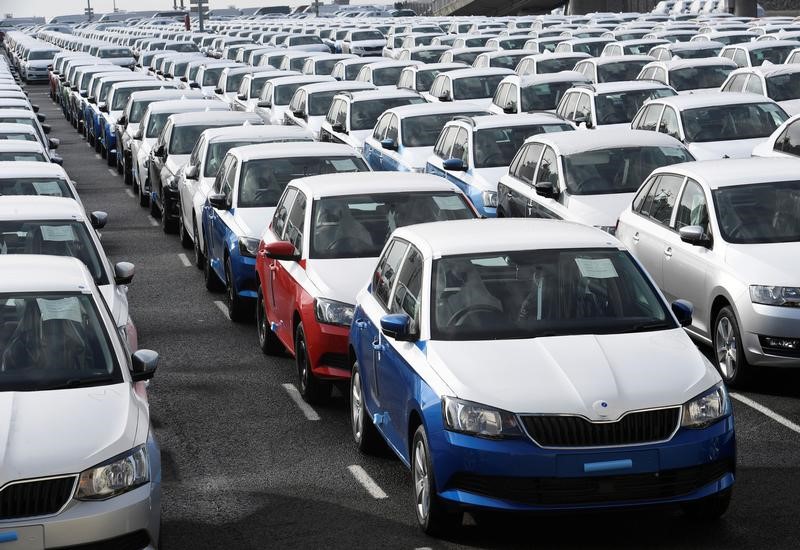By Paul Lienert and Ben Klayman
March 6 (Reuters) - Automakers and technology companies racing to develop self-driving vehicles are running into a problem: cars that can think are no good without affordable and reliable technology that allows cars to see.
With the notable exception of Elon Musk's Tesla Inc TSLA.O , most automakers have said their self-driving cars will rely on a detection system known as lidar. The state of the art sensors use laser light pulses to render precise images of the environment around the car.
Pressure to launch self-driving cars is already pushing many players to place bets on the technology. General Motors Co (NYSE:GM) GM.N , Ford Motor (NYSE:F) Co F.N and BMW BMWG.DE are expected to deploy sensors from well-funded lidar startups Velodyne and Innoviz on their initial self-driving cars over the next two years.
More than $1 billion in corporate and private investment has been plowed into some 50 lidar startups over the past three years, including a record $420 million in 2018, according to a Reuters analysis of publicly available investment data.
For a graphic, click https://tmsnrt.rs/2EAsKuC
Velodyne and Swedish supplier Veoneer Inc VNE.N will provide lidar for Ford's first automated vehicle in mid-2021, according to a source familiar with the project. Velodyne President Marta Hall describes the program as "a billion-dollar-plus deal" for the privately held lidar pioneer, whose $75,000 HDL-64E can be seen on the roofs of many self-driving prototypes in Silicon Valley.
But automakers and large suppliers have yet to settle on a winning technology, meaning there are no real sector standards for the sensors to date that would encourage mass production and lower the cost.
The initial payoff for investors and startups looks thin. Automotive lidar is expected to generate only $2.5 billion in revenue by 2025, according to industry researcher IHS Markit.
“You can overcome certain things with additional capital, but you can't overcome physics” in trying to rapidly develop, package and implement the latest lidar technology, said Austin Russell, chief executive and co-founder of lidar startup Luminar, which has funding from Volvo Cars GEELY.UL and development deals with Toyota Motor Corp 7203.T and Volkswagen AG's VOWG_p.DE Audi brand.
“That's the fundamental barrier that's holding the vast majority of the industry behind.”
Interviews with two dozen executives at startups, automakers, suppliers, investment and research firms underscored that there is plenty of chatter, but little consensus on lidar.
Toyota has partnered with several lidar startups, including Blackmore and Luminar, but the Japanese automaker continues to evaluate new sensing technologies and is not keen for a shakeout to start yet, said Ryan Eustice, senior vice president of automated driving at Toyota Research Institute.
“We want to see an ecosystem happen. There's a diversity of technology that we'd like to gauge (and) different strengths and weaknesses in how you approach the technology. It's also good to have competitive market pressure,” Eustice said.
Eventually, the lidar sector could be squeezed down to just five or six key players — as happened with the far more mature radar sensor technology. But that is not likely to unfold until after 2025 and perhaps not until 2030, executives and researchers told Reuters.
“It's going to be a long runway,” IHS Senior Analyst Jeremy Carlson said.
That presents a big risk: investing in technology that may be obsolete by the time large numbers of those vehicles start rolling off assembly lines after 2025.
If a vehicle assembler gets "too wrapped up in a technology, you might be at a disadvantage” because a newer, less expensive system could come along, said Chris Heiser, CEO of automated vehicle software company Renovo.
Even experts do not seem to agree on the etymology of the name lidar, which is either a mashup of light and radar, according to the Oxford English Dictionary, or an acronym for light detection and ranging (or, in some references, laser detection and ranging).
Nor is there full agreement on whether lidar is really necessary to make self-driving cars work.
Tesla CEO Musk insists the electric carmaker's so-called “Autopilot” system does not need it, relying instead on a combination of radar, cameras and software.
Lidar remains a relatively young technology that is still in flux, with bulky electromechanical devices such as Velodyne's popular rooftop unit rapidly transitioning to newer, more compact and more capable solid-state devices designed to sell for less than $10,000 in limited quantities, and eventually as little as $200 in mass production.
"This requires quantum leaps in innovation in lidar technology," Thomas Sedran, in charge of evaluating Volkswagen's autonomous strategy in commercial vehicles, told Reuters Tuesday at the Geneva motor show of the need to cut costs. PLC APTV.N has been among the most active suppliers in developing automated driving systems, investing in three lidar startups: Innoviz, Quanergy and LeddarTech. It is also a key supplier of automotive radar, a sensing technology often paired with lidar.
Glen De Vos, Aptiv's chief technology officer, said lidar could follow radar's extended maturation process, with technology, size, cost and reliability optimized over time as demand and production volume ramp up.
“It takes a few generations and iterations for that cost curve to come down,” he said. “It could be a five- to 10-year process.”
<^^^^^^^^^^^^^^^^^^^^^^^^^^^^^^^^^^^^^^^^^^^^^^^^^^^^^^^^^^^ GRAPHIC-Lidar startups vie for self-driving supremacy
https://tmsnrt.rs/2EAsKuC GRAPHIC-Global investment in electic vehicles
https://tmsnrt.rs/2Azl09N VW says driverless vehicles have limited appeal and high cost
